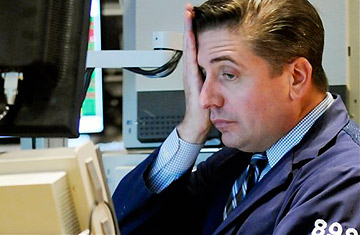
Specialist Thomas Laughlin works at his post on the floor of the New York Stock Exchange.
(2 of 3)
A Global Crisis
What made America's recklessness truly dangerous is that we exported it. A few months ago, some talked about decoupling — that Europe would carry on even as the U.S. suffered a downturn. I always thought that decoupling was a myth, and events have proven that right. Thanks to globalization, Wall Street was able to sell off its toxic mortgages around the world. It appears that about half the toxic mortgages were exported. Had they not been, the U.S. would be in even worse shape. Moreover, even as our economy went into a slowdown, exports kept the U.S. going. But the weaknesses in America weakened the dollar and made it more difficult for Europe to sell its goods abroad. Weak exports meant a weak economy, and so the U.S. exported our downturn just as earlier we had exported our toxic mortgages.
But now the problems are ricocheting back. The bad mortgages are contributing to forcing many European banks into bankruptcy. (We exported not only bad loans but also bad lending and regulatory practices; many of Europe's bad loans are to European borrowers.) And as market participants realized that the fire had spread from America to Europe, there was panic. Part of the concern is psychological. But part of it is because our financial and economic systems are closely intertwined. Banks all over the world lend and borrow from each other; they buy and sell complicated financial instruments — which is why bad regulatory practices in one country, leading to bad loans, can infect the global system.
How to Fix It
We are now facing a liquidity problem, a solvency problem and a macroeconomic problem. We are in the first phase of a downward spiral. It is, of course, part of the inevitable process of adjustment: returning housing prices to equilibrium levels and getting rid of the excessive leverage (debt) that had kept our phantom economy going.
Even with the new capital provided by the government, banks won't want to, or be able to, lend as much as they did in their reckless past. Homeowners won't want to borrow so much. Savings, which have been near zero, will go up — good for the economy in the long run but bad for an economy going into recession. While some large firms may be sitting on a bundle of cash, small firms depend on loans not just for investment but even for the working capital to keep going. That's going to be harder to come by. And the investment in real estate, which played such an important role in our modest growth of the past six years, has reached lows not seen in 20 years.
The Administration has veered from one half-baked solution to another. Wall Street panicked, but so did the White House, and in that panic, they had a hard time figuring out what to do. The weeks that Paulson and Bush spent pushing Paulson's orignal bailout plan — in the face of massive opposition — were weeks that could have been spent actually fixing the problem. At this point, we need a comprehensive approach. Another failed faint attempt could be disastrous. Here's a five-step, comprehensive approach:
1. Recapitalize banks. With all the losses, banks have insufficient equity. Banks will have a hard time raising this equity under current circumstances. The government needs to provide equity. In return, it should have voting stakes in the banks it helps. But equity injections also bail out bondholders. Right now the market is discounting these bonds, saying there is a high probability of default. There needs to be a forced conversion of this debt to equity. If this is done, the amount of government assistance that will be required will be much reduced.
It's good news that Treasury Secretary Paulson seems to finally realize that his original proposal of buying what he euphemistically called distressed assets was flawed. That Secretary Paulson took so long to figure this out is worrying. He was so bound by the idea of a free-market solution that he was unable to accept what economists of all stripes were telling him: that he needed to recapitalize the banks and provide new money to make up for the losses they incurred on their bad loans.
The Administration is now doing this, but three questions are raised: Was it a fair deal to the taxpayer? The answer to that seems fairly clear: taxpayers got a raw deal, evident by comparing the terms of Warren Buffet's injection of $5 billion into Goldman Sachs, and the terms extracted by the Administration. Second, is there enough oversight and restrictions to make sure that the bad practices of the past do not recur and that new lending does occur? Again, comparing the terms demanded by the U.K. and by the U.S. Treasury, we got the short end of the stick. For instance, banks can continue to pay out money to shareholders, as the government pours money in. Thirdly, is it enough money? The banks are so nontransparent that no one can fully answer the question, but what we do know is that the gaps in the balance sheet are likely to get bigger. That is because too little is being done about the underlying problem.
